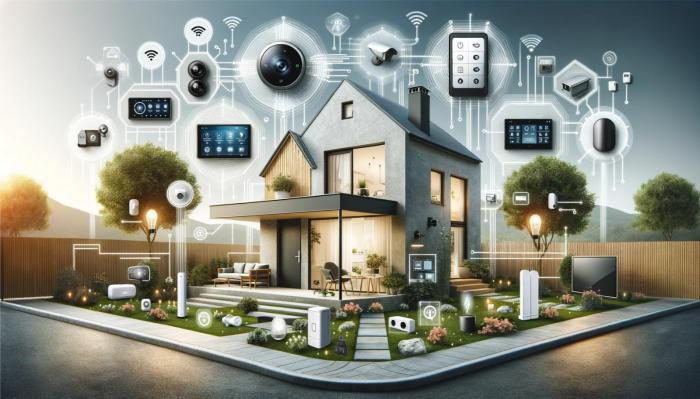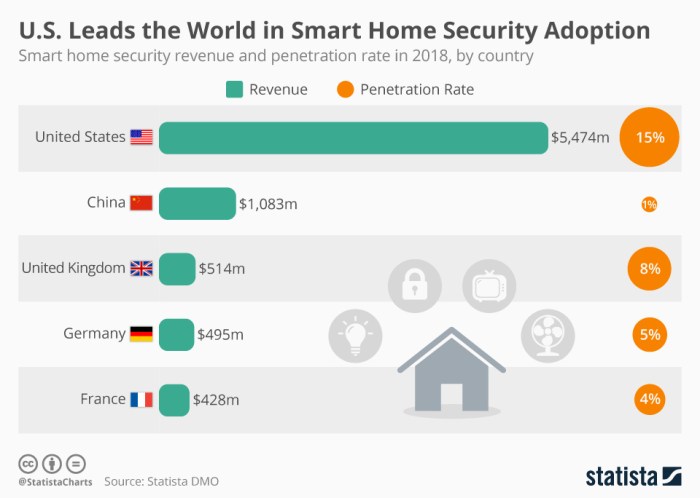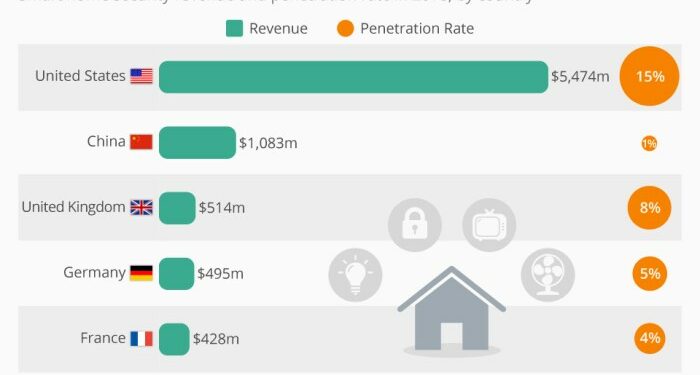Exploring the realm of smart security systems for global homes, this introduction sets the stage for an insightful discussion on the key aspects and benefits of these advanced systems.
Providing a comprehensive overview of the importance, components, and advantages of upgrading to smart security systems, this introduction aims to captivate readers' interest from the outset.
Overview of Smart Security Systems

Smart security systems play a crucial role in ensuring the safety and security of homes worldwide. These systems utilize advanced technology to provide homeowners with enhanced protection against intruders and emergencies.
Key Components of Smart Security Systems
- Video Surveillance Cameras: These cameras allow homeowners to monitor their property in real-time and record any suspicious activities.
- Motion Sensors: Motion sensors can detect movement in and around the house, triggering alarms and alerts to notify homeowners of potential threats.
- Smart Door Locks: Smart locks provide homeowners with the ability to remotely control access to their homes, enhancing security and convenience.
- Smart Alarms: These alarms can alert homeowners and authorities in case of a break-in or emergency situation, ensuring a quick response.
Benefits of Upgrading to a Smart Security System
- Enhanced Security: Smart security systems offer advanced features and capabilities that provide homeowners with increased protection and peace of mind.
- Remote Monitoring: With smart security systems, homeowners can monitor their property from anywhere in the world using their smartphones or other devices.
- Integration with Smart Home Devices: Smart security systems can be integrated with other smart home devices, creating a seamless and interconnected home automation system.
- Insurance Discounts: Many insurance companies offer discounts to homeowners who have installed smart security systems, leading to potential cost savings.
Comparison of Top Smart Security Systems

When it comes to choosing a smart security system for your home, there are several top options available globally. Each system comes with its own set of features and technology that cater to different security needs. Let's compare some of the top smart security systems and explore the technology behind them.
Features Comparison
| Smart Security System | Features | Technology Used |
|---|---|---|
| Ring Alarm | 24/7 professional monitoring, mobile app control, customizable motion detection | Wireless technology, Z-Wave integration |
| ADT Pulse | Remote access, video surveillance, smart home automation | Cellular and Wi-Fi connectivity, Z-Wave protocol |
| Google Nest Secure | Detects motion, sends alerts to your phone, integrates with other Nest products | Thread networking protocol, Bluetooth Low Energy |
Technology Overview
Smart security systems utilize a combination of wireless technology, sensors, and connectivity protocols to secure homes. The technology used can vary from system to system, with some systems relying on cellular connections for monitoring, while others integrate with smart home devices using protocols like Z-Wave or Bluetooth Low Energy.
DIY vs. Professionally Installed Systems
DIY smart security systems are designed for easy installation by the homeowner, typically without the need for professional help. These systems are often more affordable and customizable. On the other hand, professionally installed systems are set up by experts and may offer more comprehensive coverage and monitoring options, but at a higher cost.
Global Market Trends in Smart Security Systems
In today's interconnected world, smart security systems have become an essential part of keeping homes and businesses safe. Let's delve into the current trends shaping the global smart security system market
Regional Adoption of Smart Security Systems
Smart security systems are seeing a surge in adoption across various regions worldwide. Countries in North America, Europe, and Asia-Pacific are leading the way in integrating these systems into residential and commercial properties.
Growth of the Smart Security System Market
- The global smart security system market is experiencing rapid growth, fueled by advancements in technology and increasing awareness about the importance of home security.
- According to research reports, the market is projected to reach a value of billions by the end of the forecast period.
- Factors such as rising crime rates, remote monitoring capabilities, and the convenience of smart security solutions are driving the market forward.
Popular Brands and Market Share
- Leading brands like Ring, Nest, and Arlo are dominating the global smart security system industry, offering a wide range of products and services to meet diverse security needs.
- These brands have captured a significant market share due to their innovative features, user-friendly interfaces, and reliable security solutions.
- With the increasing demand for smart security systems, competition among brands is intensifying, leading to continuous product development and technological advancements.
Integration with Smart Home Devices
Smart security systems have become increasingly integrated with other smart home devices, creating a seamless and interconnected ecosystem for homeowners. By connecting to various devices, such as smart lights, thermostats, door locks, and cameras, smart security systems can enhance the overall efficiency and convenience of home automation.
Examples of Smart Security Systems Integration
- Ring Alarm: Works seamlessly with Amazon Alexa, allowing users to arm/disarm the system using voice commands and receive alerts on Echo devices.
- Nest Secure: Integrates with Google Assistant, enabling users to control the security system through voice commands and receive alerts on Google Home devices.
- ADT Pulse: Compatible with devices like smart door locks, lights, and thermostats, allowing users to create custom automation rules for enhanced security and convenience.
Convenience and Advantages of an Interconnected Smart Home Ecosystem
Having a fully interconnected smart home ecosystem offers several benefits, including:
- Centralized Control: Users can manage all connected devices, including the security system, through a single interface or app, making it easier to monitor and control their home.
- Automation and Customization: With interconnected devices, users can create custom automation rules based on their preferences, such as automatically arming the security system when the door is locked.
- Enhanced Security: Integration allows for a more comprehensive security setup, with devices working together to provide better protection and real-time alerts in case of any suspicious activity.
- Energy Efficiency: By integrating smart security systems with devices like thermostats and lights, users can optimize energy usage in their homes, leading to cost savings and environmental benefits.
Conclusion
In conclusion, the discussion on comparing the top smart security systems for global homes sheds light on the evolving landscape of home security, emphasizing the significance of embracing advanced technology for a safer living environment.
Top FAQs
How do smart security systems integrate with other smart home devices?
Smart security systems can seamlessly connect with various smart home devices like cameras, door locks, and motion sensors through a centralized hub, allowing users to monitor and control their home security remotely.
What are the differences between DIY and professionally installed smart security systems?
DIY smart security systems are self-installed by homeowners and are typically more budget-friendly, while professionally installed systems offer advanced features and professional setup for a higher cost.
Which brands dominate the global smart security system industry?
Popular brands like Ring, Nest, and Arlo have significant market share in the global smart security system industry, known for their innovative features and reliable performance.






